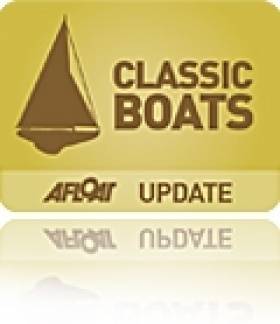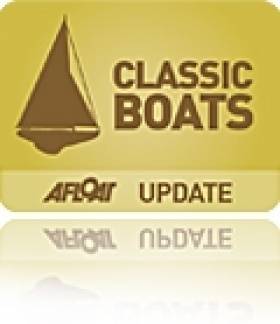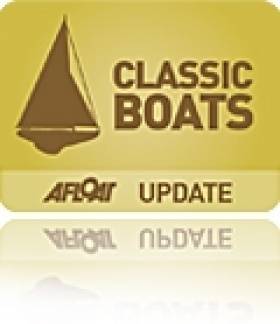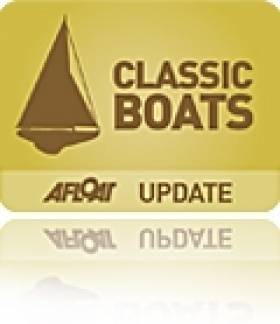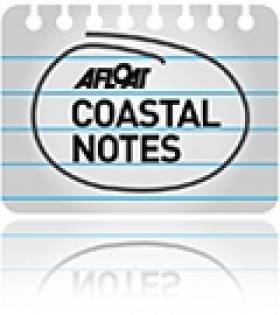Displaying items by tag: Classic boats
Cowes Classic Week Attracts New Sponsor
#classicboat – Charles Stanley has announce it has agreed headline terms of sponsorship for the 2014 Cowes Classics Week sailing event. The regatta, organised by the Royal London Yacht Club, is one of the highlights of the Classic sailing circuit and this year will hopefully see over 150 yachts with some 700 crew competing in the Solent.
The event will run from the 21st- 25th July 2014 and this year will draw entries from a wide-range of yachts and dayboats from ex-America's Cup 12-Metres to the smallest boats, the two-man Flying Fifteen Class. The ever popular day boats including the XODs, Darings, Sunbeams and Classic Day boat class traditionally draw the largest fleets whilst the Classic Cruiser/Racer division will be boosted by the inclusion of the SCODS, Twisters and Stellas, and the glass Nicholson 32's and 36's and Rustler 31's – now 50 years old. Furthermore, both the XOD and Sunbeam fleets will be using the event as a significant championship in 2014.
The 8 Metre Class Association is also confident of significant attendees and 6 Metres will continue to support the event, making the 2014 Charles Stanley Cowes Classic Week a 'must-do' event on the South Coast yachting calendar. Family entries are encouraged and the event looks forward to welcoming previous competitors in this, its seventh year of establishment. On the Solent there will be five daily courses run by the Royal London Yacht Club supported by the Royal Corinthian YC, Royal Victoria YC, Island Sailing Club and Cowes Corinthian Yacht Club.
#PreservedTUG - Brocklebank, a preserved Liverpool based tug which is still in sea-going condition is to visit Dun Laoghaire Harbour next Monday (8 July), writes Jehan Ashmore.
The tug is to make an afternoon arrival and subject to tides, the vessel will be open to the public while alongside the East Pier jetty from 14.30hrs.
Brocklebank last worked on the Mersey 25 years ago and from where she spent her entire career for Alexandra Towing Company. Fittingly the vessel stills sports the old operator's distinctive yellow, white and black band funnel colours.
In 1964 she was laid down as one of a trio of sisters (Langton and Egerton) ordered from W.J. Harwood & Sons of Great Yarmouth. In the following year she was launched by Lady Pamela Brocklebank.
During the 1960's and 1970'S she served as a ship-handling tug which involved assisting numerous cargo-ships, passenger ships and naval vessels to their berths. On occasions this involved working in Heysham, Larne and Barrow where the tug engaged with ship launches from the Cumbrian port.
The tug was acquired by the Liverpool Maritime Museum in 1989 and since then has been lovingly restored by a group of volunteers at the Merseyside Maritime Museum.
She has visited many Irish Sea ports, transited Scotland's Caledonian Canal to reach England's North Sea ports as well France. In addition she is no stranger to Irish ports, having visited Belfast, Dublin, Arklow and Cork.
#fiferegatta – Latifa's splendid port tack start across all of the other Class 1 yachts was an enthralling beginning to another day of racing for the Fife Regatta. Competitors from as far as Italy and California dressed for Scottish Sailing in full waterproofs and had a true experience of our west coast. The strong south westerly breeze reaching 30 mph at times gave exhilarating sailing for those on board and spectacular sight for those watching from the shores.
Class 1 and 2 boats left behind the lovely villages of Kames and Tighnabruaich after a superb visit. The village had hosted a BBQ, wooden boat skiff rowing races, a meal for 100 guests and a ceilidh. Yesterday a sunny cruise was enjoyed through the scenic Kyles with boats cross taking through the 'narrows' on their way from Rothesay. John Aitken sailing onboard Solway Maid described it as "fantastic and an absolute privilege." CNN camera man has been thrilled by his experience of classic yachts in Scotland and loved Sundays sailing when "Mother Nature took charge and gave dramatic sailing."
Mother Nature influenced class 3 today and their race was cancelled due to the strong winds and sea state. Prior to this announcement, Ayrshire Lass, the oldest of our fine Fifes had set off having made her decision to cruise to our destination, Portavadie marina. At 126 years she was the first to reach Portavdie after four hours of sailing, loving every minute of it and feasting on a fine supply of Glasgow made Tunnocks treats.
The Scottish owned, Saskia, the elegant 8m pure racing boat, has achieved some excellent results, but due to other racing commitments at Cowes this weekend, she is unable to complete the regatta and sadly we have to say goodbye to her tomorrow.
The famous dragon emblem of Fife's creations has been much admired and being worn with pride by all competitors and supporters of the regatta. Commemorative clothing is available through the regatta shop at Portavadie and Largs Yacht Haven for the remainder of the event.
Tomorrow sees a well earned lay day where crews can explore the local area, take a trip on the paddle steamer Waverley or simply take pleasure in visiting each other's yachts.
Class 1 winner was Latifa, the first of the regatta, now lying second overall. Class 2 continues to be closely contested between The Truant and Mikado, with Mikado claiming first place. Results are on www.fiferegatta.com
Vandals Damage Dover's Bronze Age Boat
#BronzeAgeBoat - Dover's replica Bronze Age boat has been moved to a secure location after being vandalised, according to Kent Online.
It's reported that a tent covering the vessel on the port town's Roman Lawn was damaged, and saw marks were made on one side.
The incident comes just days ahead of the launch of a campaign to fund works on the historic boat - a half-size replica of one built some 3,500 years ago - to make it seaworthy after it sank in the Dover docks last year.
A similar project in Cornwall saw the fruit of its own restoration work this past March, when their 50ft Bronze Age boat was set afloat in Falmouth.
As previously reported on Afloat.ie, the Cornish boat is crafted from two giant oak logs and using tools similar to what boat builders of the time world have used in the post-Neolithic era.
Old Gaffer Gold for Centenarian Ringsend Lady
#oga – In testing conditions on Dublin Bay, one of its own took line honours in yesterday's inaugural Leinster Trophy race on Dublin Bay. The 36ft yawl Ainmara built by John Kearney in Ringsend in 1912 and campaigned by Dickie Gomes of Strangford Lough took the race over a round Dublin Bay course of eight miles.
Upwards of ten boats participated in the first race of the Old Gaffers Association's 50th anniversary this bank holiday weekend, hosted by the Poolbeg Yacht Club, part of a necklace of events in the Round Britain Challenge to mark the association's 50th anniversary.
The 36ft–yawl Ainmara, immaculately restored by Gomes, marked her return to Dublin bay waters last Friday when she sailed back to the National Yacht Club, her first return in 90 years. Gomes with crew Brian Law and Afloat's W M Nixon were welcomed by another Kearney design, the Dublin Bay Mermaid at the harbour mouth and escorted to her East Pier berth, for an evening of celebration at the club house where Kearney was a former flag officer.
For more on the legacy of John Kearney read WM Nixon's blog and for more of the Old Gaffers click here.
Lottery Funding Confirmed for HMS Caroline
#HMSCaroline – The last remaining warship of the Royal Navy's Grand Fleet, HMS Caroline which fought at the Battle of Jutland in 1916, has been confirmed with a grant from the Heritage Lottery Fund.
The project to transform the historic Belfast-based vessel into a floating museum has been boosted by a £845,600 grant, which is to see the veteran warship undergo transformation.
The money will enable the National Museum of the Royal Navy to draw up more detailed plans to bid for a full grant of £12.2m.
For further details about the veteran vessel which is berthed at the Alexandra Dock visit the National Historic Ships UK website.
Glandore Classic Regatta Attracts Inaugural Fastnet Winner, the Pilot Cutter Jolie Brise
#classicboats – Among the regatta highlights of this Summer's Glandore Harbour Yacht Club's Classic Regatta will be the attendance of the French built Pilot Cutter Jolie Brise, winner of the inaugural Fastnet race in 1925.
The CH Marine sponsored Glandore Classic Regatta is held every two years in Glandore Harbour and attracts owners and sailors of traditional and classic working boats and yachts from Ireland and abroad.
This year the Jolie Brise is celebrating her 100th birthday this year and will participate in the Glandore Classic Fastnet race on July 23rd.
The regatta will be officially launched next week in Cork city.
Lecture: “A Hooker Evening with the Men from Kinvarra"
Poolbeg clubhouse overlooks the marina and faces the entrance to Alexandra Basin, where shipping activities of the commercial port can be viewed in closer detail.
To reach the clubhouse which is located on the South Bank, Pigeon House Road, Ringsend, take the Sean Moore Road that connects the Merrion Strand Road (from the south) and the East-Link Toll Bridge (if travelling from the northside).
For further information on the lectures to date click this link and in general about the DBOGA logon here. To contact the PYBC Tel: (01) 668 9983 or logon to www.poolbegmarina.ie/
Old Gaffers Hit the Liffey
Organised by the Dublin Bay Old Gaffers Association and the Poolbeg Yacht and Boat Club, it will also feature skiff racing involving competing men, women and mixed rowing crews from Wicklow, Dun Laoghaire, Arklow, Greystones, Bray and two entries from Ringsend, assembled by the East Coast Rowing Council.
The stretch of the river near the Poolbeg club will be a scene of constant craft movement from the Beckett and East Link Bridges downriver to entrance to Dublin Bay. The skiff racing will be over a five- hour period from 2pm.
The best vantage point for the public to be up close to the rowing action will be East Link Road from the yacht club to the East Link Bridge.
The DBOGA expect gaffers from Wales, Northern Ireland, the Isle of Man to join local craft in a parade upstream and downriver to the entrance to Dubllin Bay in a parade of over 20 craft dressed overall.
Included in the visiting craft will be WILMA, A 60-foot Baltic Trader from Port Pnryn on the Menaii Straits, the Scots Zulu Breccon Lass of the Poolbeg club, the Galway Hooker, Naomh Chronain, built by hooker enthusiasts in Clondalkin, the gaff sloop Marguerite built in Malahide 114 years ago and the engineless Happy Quest from Milford Haven.
The DBOGA's special guest for the weekend will be the noted shipwright, John Kearon, who leads the small team currently completing the conservation of ASGARD and headed for future display in the National Museum at Collins Barracks.
John Kearon has honoured the association with a special ASGARD trophy made up of original ASGARD timber and portions of new wood that has gone into her hull. This will be the major prize for all future DBOGSA events and will be competed for over a five-hour race in the bay on Saturday scheduled to start at 2pm.
That same evening victuals for the hungry racing crews will consist of a hog roast on the club premises followed by prizegiving and the first presentation of the new ASGARD Trophy.



























